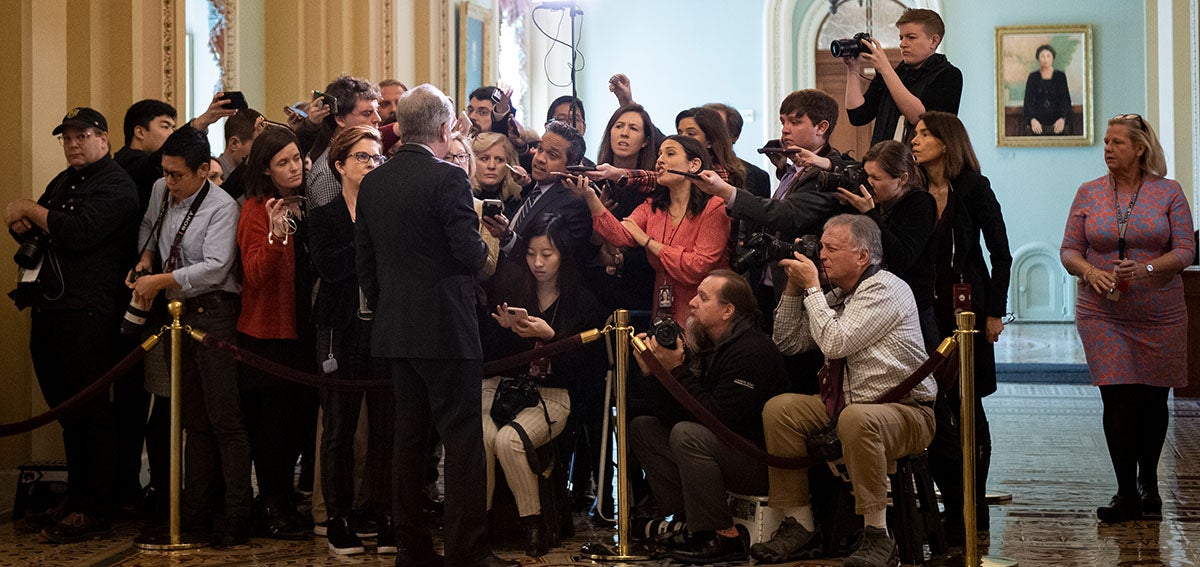 For-profit journalism has undergone seismic changes to its business model during the last 15 years. The steady stream of advertising revenue that made the industry profitable for so long is now gone. As a direct result, the infrastructure of local and beat journalism has suffered dramatic losses of capacity and quality. This is one of the prime reasons it is essential for philanthropies, for the foreseeable future, to continue providing core support for in-depth health reporting in California and nationwide.
For most of its 24-year history, the California Health Care Foundation has funded nonprofit health care journalism in California. We believe that quality health care journalism helps drive positive change in California’s health care system and prevents misinformation from gaining traction — and that nonprofit journalism platforms are best suited to accomplish this.
CHCF’s strategy for supporting health care journalism across California includes:
For-profit journalism has undergone seismic changes to its business model during the last 15 years. The steady stream of advertising revenue that made the industry profitable for so long is now gone. As a direct result, the infrastructure of local and beat journalism has suffered dramatic losses of capacity and quality. This is one of the prime reasons it is essential for philanthropies, for the foreseeable future, to continue providing core support for in-depth health reporting in California and nationwide.
For most of its 24-year history, the California Health Care Foundation has funded nonprofit health care journalism in California. We believe that quality health care journalism helps drive positive change in California’s health care system and prevents misinformation from gaining traction — and that nonprofit journalism platforms are best suited to accomplish this.
CHCF’s strategy for supporting health care journalism across California includes:
- Ensuring that there are statewide sources of health care news
- Providing core support to local public media outlets to cover health care
- Training and skill building for individual journalists
- Promoting partnerships and collaborations to focus reporting on underserved populations
Assessing Our Portfolio
In recent years, CHCF’s journalism portfolio has been anchored by a handful of core grants:- California Healthline, a daily newsletter and website that provides a mix of original reporting and aggregated news summaries
- Health reporting at public media outlets in Fresno, Los Angeles, Sacramento, San Diego, and San Francisco
- The data fellowship program at the Center for Health Journalism, a program of the USC Annenberg School for Communication and Journalism
What We Learned
The report analyzed CHCF’s strategy and concluded that the foundation’s support helps strengthen the ecosystem for health care journalism in California and helps bring high-quality journalism to a wide range of audiences statewide. Aspen found that the health reporting we support has multiple levels of impact. It contributes to community-level discussions and provides outlets the time and resources necessary to cover underreported issues. In addition, the support influences reporting by other media organizations. One outlet’s story can be compelling enough to encourage another to look for additional angles to report. These dynamics inform and advance the work of advocates and other stakeholders seeking to improve health policy and health systems, Aspen said. The Aspen research also underscored one of our key beliefs — that editorial independence is absolutely critical to the credibility and impact of journalism. Like the news media we support, CHCF is dedicated to respecting the editorial firewall that prevents funders like us from influencing what they publish and broadcast. By not dictating or putting limits on the topics covered — or the way they are covered — funders ensure that journalists can focus on the most timely and relevant issues. Protecting the independence and objectivity of their reporting is paramount. While the findings were an endorsement of our strategy, Aspen also made suggestions for steps that CHCF might take to increase the impact and value of our support, including:- Looking for ways to strengthen partnerships with ethnic media outlets to better represent the voices of underserved communities and populations
- Investigating opportunities to expand reporting in rural communities that lack coverage of local issues related to health
- Examining how media outlets might expand community engagement techniques to attract new audiences and listen to the concerns of California communities
- Encouraging larger outlets to collaborate more with smaller outlets that lack resources or expertise to cover complex health care stories
Ensuring the Health of the Health Care Journalism Ecosystem
Those recommendations prompted CHCF to commission Aspen to conduct additional research to help us better understand best practices and potential challenges in newsroom collaborations between traditional and ethnic media outlets. We also created a community engagement fund to assist public media partners seeking more targeted audience outreach around major local health stories. CHCF is proud to support health care journalism in California. We see ourselves as part of a larger philanthropic community that nurtures the relationship between quality reporting and a healthy civil society. Together, we can ensure that the state’s health care system can meet the complex needs of all Californians.Authors & Contributors

Steven Birenbaum
Steven Birenbaum is a former senior communications officer who supported CHCF’s work to improve care for patients with complex chronic conditions, including older adults and people experiencing homelessness. As a grantmaker, he set strategy to strengthen and support nonprofit journalism in California, overseeing grants to public media outlets, a data fellowship program, and the daily news digest California Heathline.
Prior to joining the foundation, Steven was executive writer at Blue Shield of California. As a writer, his work has been published in The New York Times, Newsday, the Stanford Social Innovation Review and KQED Radio, among other outlets. Steven received a bachelor’s degree in political science and history from the University of Wisconsin-Madison and a master’s of public affairs from the LBJ School of Public Affairs at the University of Texas, Austin.

